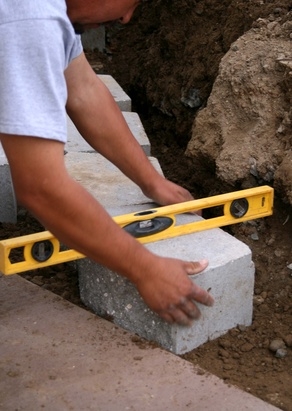
Many Australian yards have the annoying trait of being a little on the sloping side. In order to create a patio or a garden area, or if you simply want to make your job of mowing the lawn simpler, you have probably thought about leveling out your yard. This may then bring up the question: "How do I build a retaining wall?". Unfortunately constructing a retaining wall is not a small job, but if you are willing to do some digging and lifting, and enjoy working in the garden, it is manageable as a DIY project.
There are very important factors to take into consideration when undergoing a big project like this. Water and soil erosion, gravity and other geological forces need to be taken into consideration. Walls over 600mm in height should be designed with the help of a structural engineer. However walls less than 600mm high can be managed as a DIY project with minimal risk.
Here are some retaining wall types to keep in mind for your next project.
Gabion walls
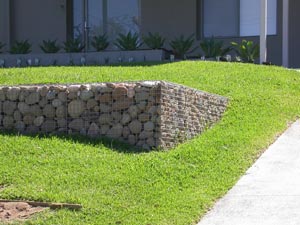
A gabion wall is constructed using wire mesh, woven in a similar fashion to a basket, which you fill with stones and form into your desired shape. The structure can be used as a fence or a retaining wall.
Note: If you use an array of stone colours and textures the effect will very different than if you use uniform rock types. And... gabion walls or fences look fantastic as retaining walls for gardens and pools.
Maintaining a gabion structure is not difficult. It is simply a matter of securing loose areas and filling in small gaps with more rock. Smaller rocks can even be "poured" into the mesh.
For large walls it is essential that you make certain they are structurally sound. Consult with an engineer if the wall is over 600mm high. Larger walls are very heavy and are a safety hazard if they are not secure.
Dry stone walls
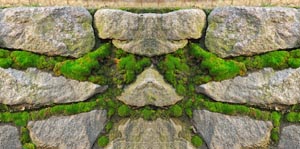
Dry stone walls can be inexpensive because the material used, rocks and cement, can be obtained very cheaply. The design and labour is what is pricey. Stone pieces are basically worked together like a jigsaw puzzle and the pieces and are fused using masonry Amateur masons should find building a dry stone wall an enjoyable project.
Anything large is best left to the professionals - keep any DIY dry stone wall construction to a small scale (less than 600mm high). Anything large needs to be properly engineered for safety and legal reasons. If you are looking for a small dry stone wall to accent a garden, this can be a very rewarding DIY project - and your wall just might outlast you!
When properly built, dry stone walls do not need very much maintenance, and they age very gracefully. Small patch-up jobs can use the same materials as the original wall - so if you are using rocks or stones that are not readily available it is advisable to keep a small stash hidden away.
Remember that the stones will need to be secured together with cement, this can hidden or slightly exposed, and ensure that any wall over 600mm in height is not directly exposed to a large load. Dry stone walls over 600m in height must have an engineered structure behind the stone facade otherwise the will collapse.
Crib walls
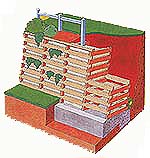
Crib walls are constructed by using interlocking blocks made of concrete or timber members and filled with stone or soil. The concrete blocks are a little pricey if you are using custom-cast (which also makes the design much trickier), but prefab models are also available. You can also purchase ready-made crib walls, that simply need to be properly installed into the desired location. Once the structure is in place, the spaces between the blocks are filled. Large crib walls, that is anything over 600mm in vertical height, should be designed by an engineer for safety purposes, but smaller retaining crib walls can be managed as a DIY project.
This is a good option if water erosion is an issue on the land where the wall will be built. Crib walls can be easily disassembled for maintenance, and the structure can be reinforced by packing rocks into empty spaces.
Concrete block walls
Concrete blocks are inexpensive, readily available and extremely durable. Building a wall with concrete blocks is hard labour, but the results will be your reward. Concrete blocks may err slightly on the unattractive side at first glance, but they can also look very neat and streamlined if the job is done well. Blocks are purchased prefab, and are basically stacked into place with a layer of permeable crushed rocks between the blocks and the soil, the idea being that a retaining wall needs to have proper drainage. There are now many attractive stone like blocks on the market so have a good look around before you choose your block.
Timber sleeper walls
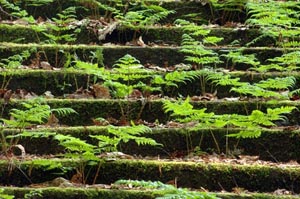
Walls made of timber sleepers look fantastic. The wood can be stained and painted any colour, matching your yard and it can be easily disassembled and changed should you change your gardening needs in the future. Although simple boards can be used, thicker blocks in exotic woods look modern and exquisite. The structure is secured using posts embedded in concrete. The posts should be at least ½ as deep into the ground as the wall is high, however this will vary depending on type of material used and ground material type.
Since a timber sleeper is of course made of timber, it will not last a forever. However, wood can age beautifully with proper maintenance (staining, waxing, weather protection, etc).

